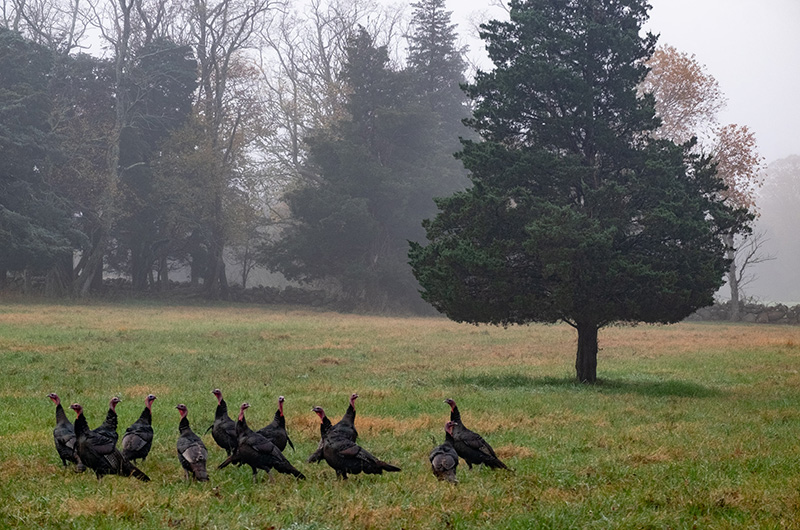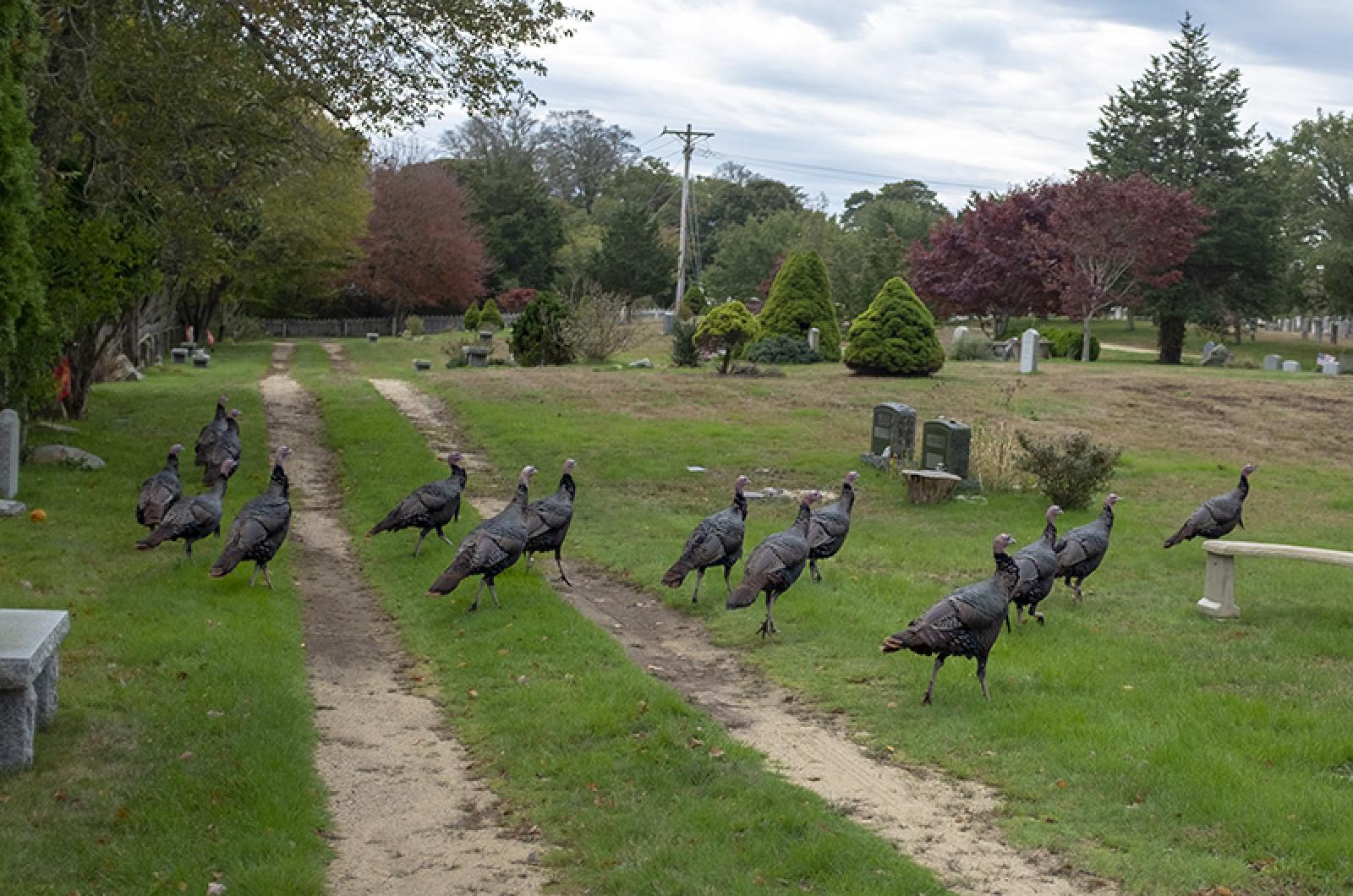Turkeys have been setting up roost around the Vineyard in record numbers, roaming the fields and rural roads with impunity, even in the weeks and days leading up to Thanksgiving. Cars stop in the road to let them pass with a precision usually reserved for children getting off a school bus.
Experts foresee the population continuing to grow and expand across the Island in the coming years.
“Turkey populations are absolutely increasing,” said Island naturalist Gus Ben David 2nd. He estimates that more than 1,000 turkeys currently reside on the Island. “The bottom line is they are thriving on the Vineyard,” he said.
“The conditions are ideal,” Mr. ben David said. “They are insectivores, carnivores, vegetarians . . . they eat anything that moves. It’s also been a number of years now since we’ve had prolonged snow on the ground. If you get prolonged snow cover, then you’ll have mortality because they don’t have access to food. They don’t have any major predators . . . They got it made.”
Even hunters give them a pass.

Massachusetts turkey hunting season occurs twice a year, for about a month in the spring and a week in the fall. Despite their abundance and status as the official state game bird, turkey hunting is rare on the Vineyard. According to MassWildlife spring turkey harvest numbers, no more than five turkeys were harvested in Dukes County in any year from 1996 to 2017. In some years, no harvests were recorded.
“Most hunters here are interested in deer, not turkeys,” said longtime Island hunter Nelson Sigelman. “We see turkeys everywhere. Enthusiastic turkey hunters will go to upstate New York or Vermont where turkey hunting really feels like turkey hunting.”
While it is agreed that turkeys arrived on the Island sometime in the early 1970s, details remain murky on who raised the original flock.
“That’s one of the great Vineyard natural history mysteries,” said Felix Neck Wildlife Sanctuary director Suzan Bellincampi. “It’s also a blame game. No one wants to take responsibility.”
Though information is scarce, there are several running theories.
Citing Susan Whiting and Barbara Pesch’s book Birds of Martha’s Vineyard, retired turkey biologist Jim Cardoza wrote in The Wild Turkey, a history of turkeys in Massachusetts, that an “unknown number of wild stock turkeys” were privately released at Felix Neck in 1970. Mr. Ben David counters that theory, saying he believes the Island turkey boom started with a small flock raised by Craig Kingsbury at his Vineyrd Haven home. Soon others began mail ordering turkeys to the Island, not for eating, but for aesthetics. Mr. Ben David said many of the turkeys trotted off and started reproducing, flourishing in a new land where they could feast all day far from predators.
Vineyard turkeys are considered domesticated feral birds, meaning they are farm birds that escaped and bred in the wild, according to Ms. Bellincampi. She said there is no evidence of wild turkeys on the Vineyard, the breed originally imported to Massachusetts that are faster and behave more aggressively around humans. She said since the Island feral turkeys have lived so close to humans for so long, they are now rarely shy when they encounter one.
“I find they aren’t afraid of people and aren’t very skittish . . . they think they own the place,” she said. “They can be aggressive, especially during their spring breeding cycle, but I’m not seeing any major cause for alarm.”
The turkey population is also growing statewide, with roughly 25,000 turkeys this year compared with 37 in the early 1970s, according to MassWildlife chief of information and education Marion Larson. She said a wild turkey flock was brought over to Massachusetts from western New York at the time to replenish the state’s turkey population that was wiped out from habitat loss in 1851. She said turkeys have now expanded to the central, northeastern, and southeastern parts of the state in both rural and urban environments.
“No one expected turkeys would thrive near people,” said Ms. Larson. “They seem to thrive in a human-built environment and a lot of that has to do with the amount of supplemental food out there.”
That doesn’t mean the co-habitation between turkeys and people has always run smoothly. In 2008, the leader of a gang of turkeys terrorized up-Island residents until it was shot at point blank range by a Chilmark police officer.
Mr. Ben David said turkeys have a habit of trampling through gardens and smashing anything where they see their reflection and mistake it for a rival.
“I’ve gotten dozens of calls to get turkeys out of their yard,” he said. “Most are irritation calls in which the turkeys are causing a problem. They can make a mess around a homestead. I’ve also gotten a lot of calls from people with damaged cars from turkeys seeing their reflection in a car window and smashing into it.”
He said more calls come in the fall because mature male turkeys begin venturing out, and crossing more roads, in “big bachelor flocks” to forage for food. He and Ms. Bellincampi agreed that drivers encountering turkeys on the road should be wary, but advised that they don’t need to come to a complete stop.
“The best thing to do instead of jamming on your brakes is to take your foot off the gas,” said Ms. Bellincampi. “Encourage them by going slow and they’ll flutter off the road.”
Mr. Ben David said he doesn’t know of any current plans to slow the expanding turkey population or encourage more turkey hunting on Island. For now, he said humans and turkeys will just have to coexist, Thanksgiving excluded.
“We’ll see what happens in a few years,” he said. “If the flocks continue to grow, it could be more of a problem.”







Comments (3)
Comments
Comment policy »